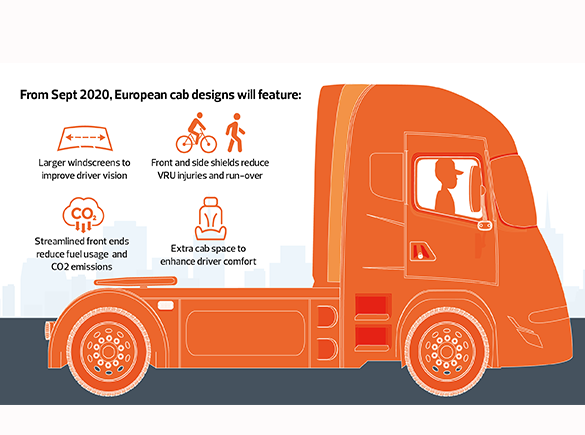The principle aim of this project was to analyse the impact of “enhanced truck front ends” on VRU and car passenger safety. The scope of this research involved the evaluation of over 100 cluster combinations for six potential safety features that included:
- Direct Vision: improvements to the field of vision available to drivers for directly observing and detecting the presence of VRUs in close proximity to the truck front end through the glazed areas of the cab.
- Indirect Vision: enhancements to the field of vision available to drivers for indirectly observing and detecting the presence of VRUs in close proximity to the truck front end through both passive camera-monitor systems and ultrasonic warning systems.
- VRU Impact Protection: advanced structural component designs, excluding the front underrun protection system, that both reduces the severity of the initial impact and directs the VRU away from the truck tyres during a collision.
- Front Underrun Protection: enhanced truck chassis designs to reduce the severity of collisions with cars by minimising their intrusion into the occupant survival space.
- VRU Airbag: an active device that detects or predicts the occurrence of a VRU collision to trigger and deploy an airbag to protect VRUs during impact.
Through this comprehensive clustered cost-benefit analysis, TRL paved the way for an additional 80-90 cm of truck cab length to be permitted in return for superior aerodynamics, enhanced driver vision, reductions in VRU run overs and improvements in driver comfort. New European truck cab designs are therefore expected to include larger windscreens to improve driver vision, as well as using tapered cabs to both enable increasingly streamlined front ends that will reduce fuel usage and CO2 emissions and better deflect VRUs away from the truck wheels during a collision. “Excitingly, the benefits of such ‘enhanced truck front end designs’ may be felt in the very near future – with longer truck cab designs permitted on Europe’s roads from 1st September 2020,” explains Dr Phil Martin, Head of Biomechanics at TRL.
With recent long-haul truck design concepts focusing on exploring the advantages in design flexibility provided by this legislation, the series production of tractor units in Europe adopting enhanced truck front end designs may only be around the corner for truck companies such as MAN, DAF, Iveco and Renault [2][3][4][5]. Interestingly, such design developments in Europe may be further accelerated due to stiff competition from across the Atlantic; with Tesla’s Elon Musk recently revealing the Tesla Semi, which would comply with the requirements of this new legislation whilst also providing the zero emission benefits of a full electric powertrain.James Nix, Freight Director at Transport & Environment (T&E), who campaigned for the introduction of the legislation explains: "European truck cabs have been shaped like bricks for the past fifty years. That’s set to change thanks to the reform of EU Weights & Dimensions law. From 1 Sept 2020 a new cab type can be placed on the market, curving back at the sides and front. Its improved aerodynamics will cut fuel use and emissions. The new shape gives real scope to improve vision and reduce collision severity for pedestrians, cyclists and car occupants. And greater cab space will help improve driver facilities such as a wider bed and shower/toilet. DAF, Renault and Tesla have already designed prototypes in line with the new rules. A key question is: which truck-makers will take advantage of the reform, and to what extent will the new cabs deliver on the potential to save fuel, emissions, and lives?”
Dr Martin adds: “Throughout this project, TRL’s role was to evaluate the cost-effectiveness of a range of safety measures in terms of their impact on VRU and car occupant safety. This was evidenced by a systematic review and critical appraisal of the literature to establish the relevant casualties, the potential effectiveness of these solutions and the cost ranges associated with each safety measure. The effects of clustering the casualty reducing benefits and production-related costs were then calculated, with the benefit-cost ratios of each individual safety measure and cluster ranked in order of cost-effectiveness to support the European Commission strategically develop its preferred implementation policy.”
“This is an example of how TRL’s research and extensive consultation support is having a significant impact on the future of international legislation,” continues Dr Martin. “It is estimated that the introduction of longer aerodynamic truck cab designs to EU fleets could prevent up to 1,200 killed or seriously injured (KSI) VRUs over the next ten years, whilst potentially reducing fuel consumption and emissions by up to ten per cent.”
TRL’s research is an example of a UK organisation affecting positive change at the heart of Europe, crucially providing an extensive clustered cost-benefit analysis, which has enabled the EU to broker an agreement based upon safety features that match with greater efficiencies and lower running costs for haulage operators. This compleiments TRL’s work on the General Safety Regulation that brought together 17 safety measures to work in harmony with each other in a single cost-effective policy. This has since culminated in the award of a contract from the European Commission to support the further development of new whole vehicle type-approval requirements for all 17 safety measures, including providing support for developing the world’s first automated regulations for cars.
Dr Martin concludes, “While the safety benefits of improving the structural design of box-shaped truck cabs are well established and are now underpinned by regulation, other sectors with similar flat front-end vehicle designs have been slow to explore and adopt these best practices. As city bus and coach collisions with VRUs may also benefit from tapered front end designs that improve driver vision and reduce the risks of run-overs, TRL calls on these sectors to investigate the potential impact that similar changes in designs may have on the safety of VRUs and reduction of emissions associated with their sectors.”
[1] https://ec.europa.eu/transport/road_safety/sites/roadsafety/files/pdf/statistics/dacota/bfs2017_hgvs.pdf
[2] Renault: http://www.renault-trucks.co.uk/news/optifuel-lab-3-aims-to-reduce-fuel-consumption-by-13p100.html
[3] DAF: https://iepieleaks.nl/daf-prototype-on-the-road/
[4] IVECO: https://www.iveco.com/singapore/company/pages/z-truck.aspx
[5] MAN: http://int.krone-trailer.com/fileadmin/contentmedia/pdf/prospekte/aero_liner_en.pdf

